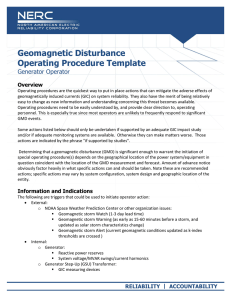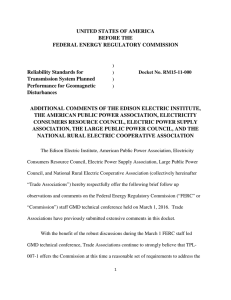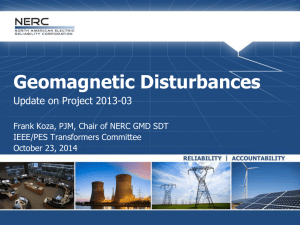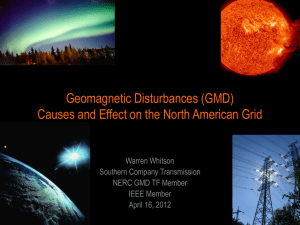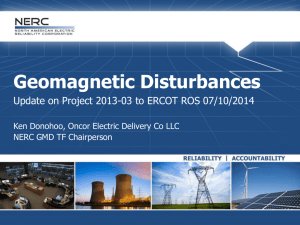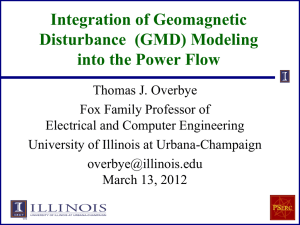Bonneville Power Administration Solar Magnetic Events GMD/GIC
advertisement
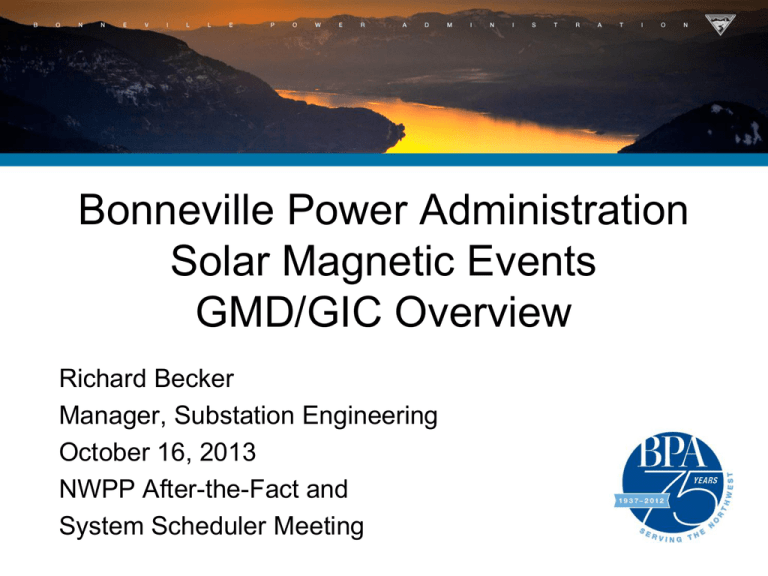
Bonneville Power Administration Solar Magnetic Events GMD/GIC Overview Richard Becker Manager, Substation Engineering October 16, 2013 NWPP After-the-Fact and System Scheduler Meeting Overview 1. What is a Geomagnetic Disturbance (GMD) 2. What are the concerns 3. What is being done to better understand effects and impacts 4. How to manage adverse impacts 5. What study and operational management tools are available and on the horizon 6. Technical limitations for where we are today 2 2 Solar Cycle 24 - The probability of GMD’s 3 History of Cycles Take note 1859 1921 •While the probability differs, a Coronal Mass Ejection and subsequent Geomagnetic Disturbance can theoretically occur at any time. •We have a clear history of a number of Severe GMD and they do impact electric Power grids (1859, 1921, 1992, 1989, 2003, etc.) 4 Uncertainty in Prediction 5 Doomsday GMD Scenario “Linked to the celestial spectacle are enormous fluctuations of the magnetic field in Earth's magnetosphere, which are causing immense flows of electric current in the upper atmosphere over much of the planet. Those huge currents disturb Earth's normally quiescent magnetic field, which in turn induces surges of current in electrical, telecommunications, and other networks across entire continents. Streetlights flicker out; electricity is lost. A massive planetary blackout has occurred, leaving vast swaths of North and South America, Europe, Australia, and Asia without power. Within a few months, the crisis has deepened. In many areas, food shortages are rampant, drinking water has become a precious commodity, and patients in need of blood transfusions, insulin, or critical prescription drugs die waiting. Normal commerce has ground to a halt, replaced by black markets and violent crime. As fatalities climb into the millions, the fabric of 6 society starts to unravel.” US “Doomsday” Scenario According to the scenario.. •Based on a projected 5,000 nT/min storm, a large numbers of EHV transformers will fail • Since transformers are custom-built and not sourced domestically (This is changing), recovery could take years 7 Coronal Mass Ejections Magnetosphere Energetic Charged Particles Heliosphere Ionosphere 8 GMD Detection 9 NASA Solar Wind Prediction Source: WSA-Enil Solar Wind Tool 10 A Recent “Near Miss” “On July 23rd 2012, a powerful event occurred on the sun. The eruption however, was on the far side of the sun; consequently, we are not expecting any geomagnetic activity. It is likely that if this event had occurred ~10 days earlier when the sunspot cluster was facing Earth, we would have initiated the NERC/RC telecon for a likely extreme geomagnetic storm. The flare was huge and the CME was very fast. The CME impacted the STEREO spacecraft ~1920 hours after the eruption on the sun. That would put it in the Carrington 1859 (17.6 hrs), Halloween 2003” 11 The Physics: Geomagnetic Disturbances Near Earth’s Surface Space Solar Flare CME Interaction with Earth’s Magnetic Field B t E Maxwell Eq. & Earth Cond. Model Grid Model GIC 12 Induced GIC Flow from Electric Field 13 What are the risks to operation of the bulk power system from a strong GMD? • The most significant issue for system operators to overcome a severe GMD event is to maintain voltage stability. • As transformers absorb high levels of reactive power, protection and control systems may trip supporting reactive equipment due to the harmonic distortion of waveforms. • In addition, maintaining the health of operating bulk power system assets during a geomagnetic storm is a key consideration for asset managers. • There is also the indication that GIC could lead to failure of Transformer Banks in unusual circumstances. 14 What transformers are at risk from a GMD? The magnitude, frequency, and duration of GIC, as well as the geology and transformer design are key considerations in determining the amount of heating that develops in the windings and structural parts of a transformer. The effect of this heating on the condition, performance, and insulation life of the transformer is also a function of a transformer’s design and operational loading during a GMD event. 15 Continued Some older transformer designs are more at risk for experiencing increased heating and VAr consumption than newer designs. Additionally, transformers that have high water content and high dissolved gasses and those nearing their dielectric end-of-life may also have a risk of failure. 16 GIC Impacts on Transformer Reactive 17 John Kappenman, Geomagnetic Storms and Their Impacts on the U.S. Power Grid, Metatech Corporation Meta-R-319 p 20 Thermal Stress from Half Cycle Saturation Thermal models are needed to know if a transformer is operating beyond thermal capability, and work is underway to develop models that translate GIC winding current to a hot spot temperature. 18 Harmonic Current Transformers become significant sources of harmonic current during GMDs Shunt Capacitors and Filters can become overloaded Protection Systems can be vulnerable to harmonic distortion 19 Effects of GIC in HV Network GIC flows in lines Can lead to voltage collapse and blackout Transformer half-cycle saturation Harmonics P&C incorrect operation Reactive power loss Transformer heating Capacitor bank or SVC Tripping – loss or reactive support Generator overheating and tripping Voltage control, limits, contingency management Voltage and angle GIC simulations stability Power system simulations 20 GMD Probability >300nT/min 21 NERC GMD Task Force Report Major Conclusion • Most likely result from a severe GMD is the need to maintain voltage stability Major Conclusion • System operators and planners need tools to maintain reactive power supply Major Conclusion • Some transformers may be damaged or lose remaining life, depending on design and current health 22 Severity Indexes Local Global Solar Activity A Index Level K Index Level Quiet A Index <7, Usually no K-indices >2 Unsettled 7 < A Index < 15, Usually no K-indices > 3 Active 15 < A Index < 30, A few K-indices of 4 Minor Geomagnetic Storm 30 < A Index < 50, K-indices mostly 4 and 5 Major Geomagnetic Storm 50 < A Index <100 K-indices mostly 5 and 6 Severe Geomagnetic Storm A Index>100 K-indices 7 or greater Kp Index NOAA Space Weather Scale Geomagnetic Storm Levels Kp=5 G1 (Minor) Kp=6 G2 (Moderate) Kp=7 G3 (Strong) Kp=8 G4 (Severe) Kp=9 G5 (Extreme) 23 What Happens in case of a GMD? IRO-005-3.1a R3. Each Reliability Coordinator shall ensure its Transmission Operators and Balancing Authorities are aware of Geo-Magnetic Disturbance (GMD) forecast information and assist as needed in the development of any required response plans. This will typically happen at a K7 index level. 24 Geomagnetic Disturbance Mitigation FERC issued order 779 in May 2013 directing NERC to develop reliability standards to address the potential impact of geomagnetic disturbances (GMDs) on the reliability operation of the Bulk-Power System. As directed in order 779, developed in two stages Stage 1 standard(s) will require applicable registered entities to develop and implement Operating Procedures that can mitigate the effects of GMD events. EOP-010-1 - Geomagnetic Disturbance Operations Stage 1 standards must be filed by January 2014. Stage 2 standard(s) will require applicable registered entities to conduct initial and on-going assessments of the potential impact of benchmark GMD events on their respective system as directed in order 779. Stage 2 standards must be filed by January 2015. 25 NERC Alert: Anticipating GMD Actions to be considered : 1. Increase import capability: • Discontinue non-critical maintenance work and restore out-of-service transmission lines, wherever possible. • Evaluate postponing/rescheduling planned outage and maintenance activities. Avoid taking transmission lines out of service unless reliability affects of the line outage has been evaluated. 2. The Reliability Coordinator may instruct Generator Operators to increase real and reactive reserves to preserve system integrity during a strong GMD event by performing such actions as: Reducing generator loading 26 NERC Alert: Anticipating 3. Transmission Operators and Generator Operators should increase situational awareness and enhance surveillance procedures. Reliability Coordinators should be informed of all actions such as: • Unusual voltage and/or MVAr variations and unusual temperature rise are detected on transformers and GSU’s. • Abnormal noise and increased dissolved gas on transformers, where monitoring capability exists. • Trips by protection or unusual faults that are detected in shunt capacitor banks and static VAR compensators. 27 Real-Time Operations 1. Increase reactive reserves and decrease loading on susceptible equipment and coordinate the following actions with the Reliability Coordinator such as: • Bring equipment online to provide additional reactive power reserves. • Increase dynamic reactive reserves by adjustment of voltage schedules or other methods. • Reduce power transfers to increase available transfer capability and system reactive power reserves. • Decrease loading on susceptible transformers through reconfiguration of transmission and re-dispatching of generation. 28 Real Time 2. Increase attention to situation awareness and coordinate information and actions with Reliability Coordinator such as: • Reduce power output at susceptible generator stations if erratic reactive power output from generators or excess reactive power consumption by generator step-up transformers is detected. • Remove transmission equipment from service if excessive GIC is measured or unusual equipment behavior is experienced and the system affects of the equipment outage has been evaluated. 29 Utility Actions to Assess and Prepare Assure you have appropriate procedures Estimate vulnerability of system equipment and protection schemes to GIC. (Model and simulate). Increase visibility of GIC on the system (Real time measurement) Assure you have system equipment and protection schemes to mitigate vulnerability 30 Operating procedures/practices Revising operational procedures as we obtain new information out of the NERC Task Force effort GIC current measurement displayed on dispatch screen for monitored transformers Adding GIC flow alert to signal Dispatch that GIC conditions exist as part of voltage control management (e.g. 20A greater than 20 seconds) 31 Transformer Monitoring BPA is replacing our first vintage neutral current monitors with measurement that also includes: • DC amps • VARS • Harmonics • Tank wall vibration 32 New GIC monitor 33 New GIC monitor 34 SCADA – Autotransformer Neutral Amps DC 35 GIC Modeling and Studies Contracted a GIC study through a commercial software vendor 115 kV to 500 kV This partnership has helped obtain resistive modeling data from neighboring utilities First VAR demand sensitivity study of grid completed September 2013 36 Preliminary study results Transformer/Substation Parameter There are 842 transformers in the study footprint with primary voltages of 115kV and above 37 Uniform Field Modeling Results 1V/km, 75 degree orientation GIC 3 phase Transformer MVAR Losses Including 115kV excluding 115kV difference 1335 1265 70 or 5.24% 38 Uniform Field Modeling Results Apply Neutral Blocking 39 Real time Simulators Working on modeling with NRCan simulator to compare performance against GIC monitor data Looking to use study models and simulators to perform sensitivity studies to determine locations of high GIC flow to pre-inform system operators of potential trouble Industry needs a real time tool in addition to preworked scenario studies of the network 40 NRCan GIC Simulator – BPA model 41 Still needed Need NERC GMD TF deliverables for transformer behavior curves to know decision points for transformers operating under GIC conditions: (VAR, Harmonics, and Thermal stress) Cross validation of study tools and modeling techniques to verify reasonable and useable results are being obtained Better GIC handling specifications for new transformers 42 INFORMATION NERC GMD TF 2 Deliverables http://www.nerc.com/comm/PC/Geomagnetic%20 Disturbance%20Task%20Force%20GMDTF%20 DL/GMD_Phase_2_Project_Plan_APPROVED.p df 43 Other Information Sources http://www.nerc.com/comm/PC/Pages/Geo magnetic-Disturbance-Task-Force(GMDTF)-2013.aspx http://www.geomag.nrcan.gc.ca/lab/defaulteng.php http://www.epri.com/abstracts/Pages/Produ ctAbstract.aspx?ProductId=000000000001 026425 44 http://www.nerc.com/files/2012GMD.pdf http://www.nerc.com/comm/PC/Pages/Geo magnetic%20Disturbance%20Task%20For ce%20(GMDTF)/GeomagneticDisturbance-Task-Force-GMDTF.aspx http://www.nerc.com/pa/Stand/Pages/Proje ct-2013-03-Geomagnetic-DisturbanceMitigation.aspx 45
